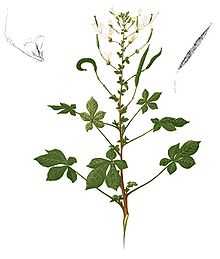Cleome gynandra
| Cleome gynandra | |
|---|---|
 | |
| Scientific classification | |
| Kingdom: | Plantae |
| (unranked): | Angiosperms |
| (unranked): | Eudicots |
| (unranked): | Rosids |
| Order: | Brassicales |
| Family: | Cleomaceae |
| Genus: | Cleome |
| Species: | C. gynandra |
| Binomial name | |
| Cleome gynandra L. | |
| Synonyms[1] | |
|
List
| |
Cleome gynandra (Sanskrit: Ajagandha, अजगन्धा;[citation needed] Marathi:Tilavan, तिलवन; Kenyan (Kisii):Chinsaga) is a species of Cleome known by the common name Shona cabbage or African cabbage. It is an annual wildflower native to Africa but has become widespread in many tropical and sub-tropical parts of the world. It is an erect, branching plant generally between 25 cm and 60 cm tall. Its sparse leaves are each made up of 3-5 oval-shaped leaflets. The flowers are white to rose pink. The seed is a brown 1.5mm diameter sphere. The leaves are edible.
Uses
The leaves form an important part of diets in Southern Africa, and nutritional analysis has found it to be high in certain nutrients including amino acids, vitamins and minerals.[2] In Telugu, C. gynandra is termed as Vaminta or Vayinta. In India, many tribes cook the leaves of this herb like any other leaf curry.
Ecology
Cleome gynandra is considered an invasive weed in many places in the U.S.[3] and elsewhere in the Pacific.[4]
Biochemistry
Cleome gynandra uses NAD-malic enzyme type C4 photosynthesis and has the characteristic traits associated with this including changes in "leaf biochemistry, cell biology and development".[5] Cleome gynandra is closely related to Arabidopsis thaliana (a C3 photosynthetic plant) and therefore offers comparison with this well studied model plant.
References
- ↑ "The Plant List: A Working List of All Plant Species". Retrieved January 26, 2014.
- ↑ Cleome gynandra L. entry in Plantzafrica database
- ↑ USDA-NRCS: Invasive and noxious weeds
- ↑ Cleome gynandra: Plant threats to Pacific ecosystems (Pacific Island Ecosystems at Risk project (PIER))
- ↑ Marshall, D.M., Muhaidat, R., Brown, N.J., Liu, Z., Stanley, S., Griffiths, H.G., Sage, R.F., Hibberd, J.M. (2007) Cleome, a genus closely related to Arabidopsis, contains species spanning a developmental progression from C3 to C4 photosynthesis. Plant Journal, 51: 886-896